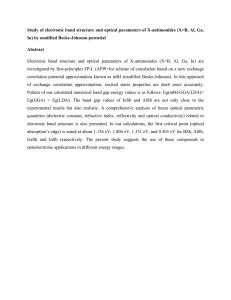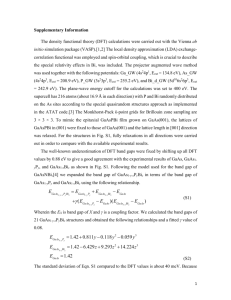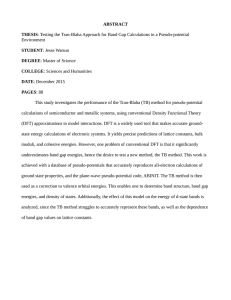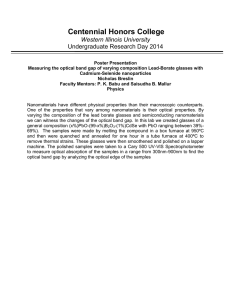Document 14796399
advertisement
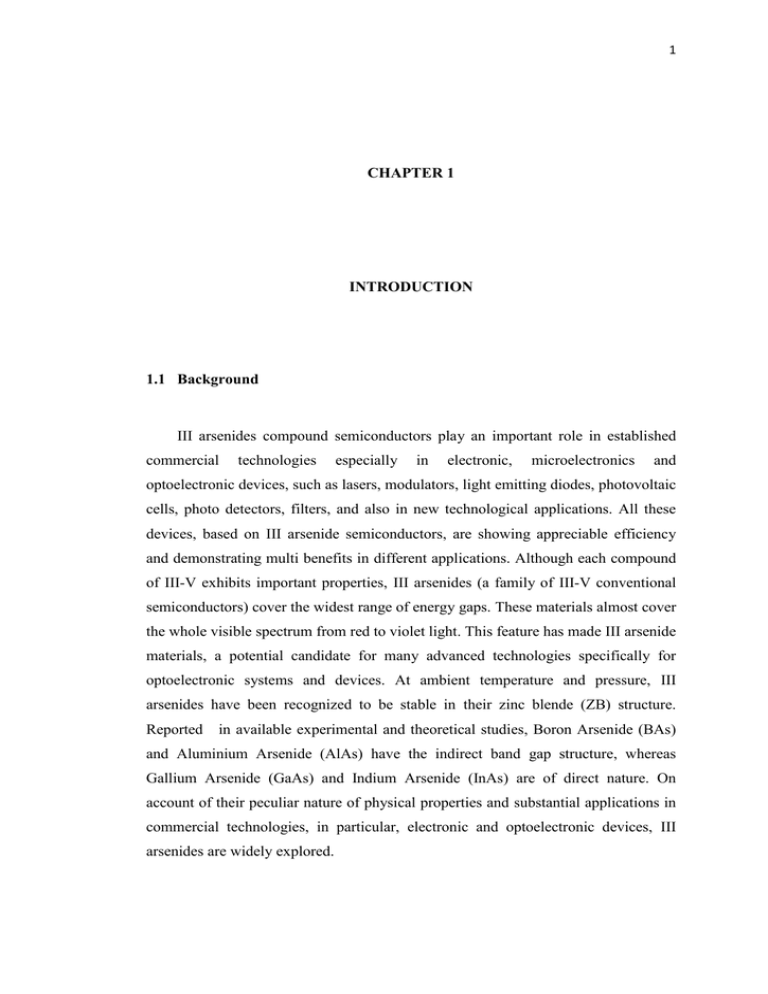
1 CHAPTER 1 INTRODUCTION 1.1 Background III arsenides compound semiconductors play an important role in established commercial technologies especially in electronic, microelectronics and optoelectronic devices, such as lasers, modulators, light emitting diodes, photovoltaic cells, photo detectors, filters, and also in new technological applications. All these devices, based on III arsenide semiconductors, are showing appreciable efficiency and demonstrating multi benefits in different applications. Although each compound of III-V exhibits important properties, III arsenides (a family of III-V conventional semiconductors) cover the widest range of energy gaps. These materials almost cover the whole visible spectrum from red to violet light. This feature has made III arsenide materials, a potential candidate for many advanced technologies specifically for optoelectronic systems and devices. At ambient temperature and pressure, III arsenides have been recognized to be stable in their zinc blende (ZB) structure. Reported in available experimental and theoretical studies, Boron Arsenide (BAs) and Aluminium Arsenide (AlAs) have the indirect band gap structure, whereas Gallium Arsenide (GaAs) and Indium Arsenide (InAs) are of direct nature. On account of their peculiar nature of physical properties and substantial applications in commercial technologies, in particular, electronic and optoelectronic devices, III arsenides are widely explored. 2 The rapid advancements in the field of information technology and device applications demands a dire need to further investigations related to this class of materials to exploit their hidden potential for future applications. Investigations of the physical properties of materials at atomic scale and their exploitation are very important and challenging. Fundamental understanding of the physical properties at atomic scale requires the application of quantum mechanics but to explore the properties of materials at atomic scale is a time taken and a complicated problem. To overcome this difficulty, first principles based computational approaches are considered to be more reliable tool because of their ability to explore the physical properties of materials with high accuracy in short time and reduced cost in comparison with experimental study. These charming features of computer simulation motivated us to do investigation of some fundamental properties for III arsenides by using density functional theory (DFT) [1, 2] based method of calculations. It is because, among III arsenides compound family, BAs, AlAs, GaAs and InAs are the most significant due to their potential applications in semiconductor industry. Also the structural and electronic properties of these materials are of considerable importance in both fundamental and applied physics, and extensive research is going on at both levels (experimentally and theoretically) due to their potential applications in electronic/optoelectronic devices [3-34]. 1.2 Problem Statement To study the structural, electronic and optical properties of the materials, it is important to understand their features. To take insight view of these properties theoretically, a systematic solution of Schrodinger many body equation is crucial. The solution of the Schrodinger much body equation analytically is too difficult. However DFT based computational approaches provide a way out to simplify such kind of complex problem by transferring the many body equation into one particle independent Kohn-Sham equations. 3 Though the investigations regarding structural, electronic, and optical properties of III arsenides have been discussed in a number of studies, there is still problem in doing calculation accurately comparable to the experimental value specifically electronic properties within standard DFT. To address this crucial problem of DFT, different exchange correlation (XC) functionals have been implemented in this study to investigate III arsenides structural, electronic and optical properties. The calculations of lattice parameters, bulk moduli, electronic band structure, energy band gap along with optical parameters is presented comprehensively. In this research, LDA, PBE-GGA, and WC-GGA exchange-correlation functional are employed within DFT to deal with structural parameters. For the electronic properties, modified Becke-Johnson (mBJ) exchange potential incorporated into standard LDA and GGA is additionally applied. Furthermore, the obtained results in this research work with different approximations are compared with the previously reported experimental and theoretical works. 1.3 Objectives The main interest of this research is to understand and apply state of the art of full potential linearized augmented plane-wave plus local orbitals FPL(APW+lo) approach to perform a study on the structural, electronic and optical properties of III arsenides (BAs, AlAs, GaAs and InAs). The objectives of this study are as follows: 1. To investigate the structural, electronic and optical properties of III arsenides (BAs, AlAs, GaAs and InAs) in their zinc blende (ZB) phase. 4 2. To study the impact of different approximations on the structural, electronic and optical properties and to find out which approximation provides better choice for reliable results in comparison to experimental values. 3. To investigate the effectiveness of FP-LAPW approach using WIEN2k code on the properties of III arsenides. 1.4 Scope of Study A right knowledge of the physical properties of III arsenides compounds is crucial for their prospect applications. This study may be a good addition in the body of knowledge concerning different properties of III arsenides materials and their suitability in present and future applications as well performed within different exchange correlation functional. In this research work, the ZB structures of III arsenides were simulated using experimental values of lattice parameters. For the investigations of physical properties of these materials, DFT based FP-L(APW+lo) methodology is employed. To realize these properties, computations are carried out taking into account relativistic effect within scalar relativistic approximation. To determine structural properties, the exchange–correlation energy of electrons as depicted in LDA, PBE-GGA and WC-GGA is used. For band structure calculations, in addition to LDA and GGA, the modified Becke-Johnson (mBJ) exchange potential is also used that allows the reproduction of band gaps values with accuracy similar to very expensive GW calculations. Furthermore in this study, for optical properties, we use mBJ+LDA and mBJ+GGA. From here we can see the suitability of each approach in calculating the properties of III arsenides. In short; 1. III arsenides are studied in their zinc blende phase structures 2. Lattice constants, bulk modulus and its pressure derivative, and total energy for each compound of III arsenides are studied for the structural properties. 5 3. Band structure and band gap energy are studied for the electronic properties. 4. The dielectric function, absorption, reflectivity, refractive index and energy loss are studied for their optical properties. 5. Density functional theory is used to calculate and simulate the structural, electronic and optical properties of III arsenides. 1.5 Significance of Study The efficiency of a device not only depends on the quality of its engineering, it also requires clear knowledge about the physical properties of the base material, and the understanding of fundamental science behind their characteristics. It is therefore very important to know the different properties of the III arsenides to expose their further potential. The findings of this study related to the structural, electronic and optical properties of III arsenides compounds using different approaches of exchange correlation functional will also be useful to design new materials as well as to investigate the properties of known materials for academicians and industrial researchers. Also our findings related to III arsenides lattice parameters, band gap values, band structure, bulk moduli and optical parameters will play important role to widen further spectrum of the III arsenides applications and to determine the effective usage of these materials in the semiconductor devices. By calculating these properties, we can obtain the informations of these materials. The study of these properties also may be helpful in the specifications needed for its quality control for the material’s production in different applications. Besides that, this computational calculation enables the system to be investigated where experiments are very expensive which is difficult or even impossible to perform. 6 1.6 Previous Studies III-V semiconductors are essential for their unfailing applications as base materials for device fabrications in current and future electronic, microelectronic and optoelectronic industries. Among these, III arsenides are of particular interest for their unique physical properties like wide band gaps, low density, high thermal conductivities, and dielectric constants [30]. At ambient temperature and pressure, III arsenides have been recognized in zinc blende (ZB) stable structure. Their fundamental band gap both experimentally and theoretically is reported indirect for BAs and AlAs and direct for GaAs and InAs. Also III arsenides almost covers whole visible spectrum from red to violet light. These properties have made this class of materials potential candidate for light emitting diodes, lasers, photo detectors, integrated circuits, modulators, filters, and many more other advanced technologies. On account of their peculiar nature of physical properties, and substantial applications in commercial technologies specifically in electronic and optoelectronic devices, III arsenides are widely explored [3-34] Each member of this group demonstrates unique electronic structure and corresponding physical properties. BAs exhibit strong covalent nature [27], and have analogous electronic nature to silicon that led it unique among the other III compounds [28]. Being a wide band gap semiconductor BAs is considered a suitable partner for alloying with GaAs and AlAs [29]. However because of difficult synthesis of BAs its properties are under debate [36]. Similarly GaAs, owing to direct wide band gap and having small effective mass of electrons, besides many other applications, is exploited as ultra fast transistors especially where reliability is the main point. Likewise, InAs and AlAs play fundamental role as a part of many optoelectronic heterojunction devices and systems. The operating features of these electronic and optoelectronic devices require a fully understanding of the properties of materials, and the fundamental science behind these properties on its material engineering and also at practical level. Because of technological importance, clear understanding about physical properties and their science is very essential. Therefore experimental and theoretical investigations are of fundamental interest. 7 Theoretically, most of the studies are performed using first principles approaches: Chimot et al. [98] have studied structural and electronic properties of BAs, GaAs, InAs and there alloys within the DFT framework of virtual crystal approximation. They have recommended III arsenides materials and their alloys as an alternative to the InP substrate, for the epitaxial growth of nanostructures to fabricate field effect transistors, lasers and storable absorbers in the field of optoelectronics. Zaoui et al. [37] and A. Boudjemline et al. [38] have reported the electronic and optical properties of BAs using LDA and GGA within DFT. Using a FP-LAPW method Arabi et al. [25] have studied structural and electronic structure of GaAs in four different phases. Ahmed et al. [4] have also investigated structural and electronic properties of III arsenides using LDA, GGA and GGA proposed by EngelVosko (EV). Amrani et al. [39] have studied the structural parameters, electronic and optical properties and variation in it under higher pressure using FP-LAPW method using LDA as an XC potential. Ground state and high pressure structural parameters were also investigated by Wang et al. [40] using full potential linearized muffin-tin orbital (FP-LMTO) scheme at the level of GGA within the frame work of DFT. Similarly Hart et al. [29] have investigated ground state as well as electronic properties of BAs, AlAs, InAs and GaAs within DFT using LDA approximation. Most recently Guemou et al. [41] have studied the structural and electronic properties and optical properties of BAs, GaAs and their alloys using LDA and GGA. Although a sizeable number of theoretically investigations have been reported in literature previously using different forms of exchange correlation functional, mostly reproduce underestimated values of fundamental band gap values especially in case of semiconductors and insulators and corresponding optical properties. Right knowledge of fundamental and optical band gap is important in the study of physical properties of materials as it play decisive role for their applications as a base material in electronics and optoelectronics devices, to exploit their potential for further applications. Though DFT based on computer simulation have made it possible nowadays to investigate electronic band structure at atomic scale and the corresponding fundamental properties of materials in amazingly short time with low cost, and have predicted the properties of materials that yet not synthesized, reproduction of accurate electronic band gap within conventional DFT is not 8 straightforward. It is because DFT is basically designed to cope up ground state properties, however to overcome this difficulty a proper choice of XC potential functional is crucial to reproduce electronic band gap and optical properties comparable to experimental measurements. One of them is the Tran- Blaha (TB) modified Becke Johnson (mBJ) XC potential, which has been reported in several studies of semiconductors and insulators to calculate energy gap with high accuracy or near to the experimental value. The highly accurate results at effectively low cost have proclaimed mBJ as superior on other approaches. Motivated by fascinating features of DFT computer simulations, the important applications of III arsenides in cutting edge technologies and balance role of mBJ+LDA exchange and correlation potential to reproduce band gap for semiconductors and insulators, we investigate some of fundamental properties of III arsenides using FP-L(APW+lo) framed within DFT [2,42]. However to investigate the response of XC-potential to band gap calculation we employ mBJ+LDA in addition to LDA, PBE-GGA and WC-GGA. Calculations are also performed related to optical properties. 1.7 III-V Semiconductors III-V semiconductors are formed by chemical elements from group III and V with every atom group of III is bound to four atoms of group V atoms and every group of V atom is bound to four atoms of group III atoms in the crystal structure of III semiconductors. These III semiconductors are able to build binary, ternary, quaternary and also higher-order compound to provide extensive potential for engineering of the semiconductor band gap and the related emission or absorption wavelength which are vital properties for optoelectronic and microelectronic applications. 9 1.8 Modeling and Simulation A set of mathematical equations or physical model is used in modeling technique in order to clarify it as a real system. By changing its variables, according to their behavior and performance of the system, prediction can be made. Computer simulation helps to see how the system works on the models and therefore a study on the models can be made. Computational science has become a vital tool in modeling and simulation. Modeling and simulation are usually achieved by the aid of computational science and therefore they are always referred to computer modeling and computer simulation. Computational science could be defined as an interdisciplinary approach that uses concepts and skills from the science, computer science and mathematics disciplines to solve complex problems in the study of various phenomena which can be illustrated by Fig. 1.1. Applied Science Mathematics Computational Science Computer Science Figure 1.1: Computational science is defined as the intersection of the three disciplines, i.e. computer science, mathematics and applied science.
